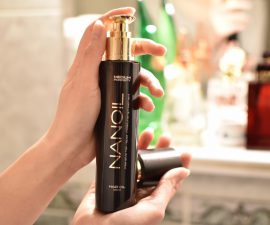Hair damage has plenty of causes like the sun, stress, wrong hair care and styling routine. What to do to get your hair’s healthy shine and elasticity back? Discover the ingredients that damaged hair needs the most and choose the ones that are ideally suited to your daily hair care.
If you have an impression that you’ve tested all products labeled “for damaged hair” but your hair remains split and brittle, it’s highly likely that you haven’t tried these ingredients. Take a look at substances that are essential for damaged hair – search for them in shampoos, conditioners and masks. If you dare, make your own hair-repair blend.
What does damaged hair need?
Damaged hair is lifeless and lacks the thing that makes a fundamental element of a healthy, resilient hair. In other words, it lacks proteins or amino acids; among them, keratin is the main hair-building protein. This doesn’t mean that keratin is the only one that saves hair crying for help. You can repair damaged, weak strands by delivering different forms of proteins.
On the other hand, you must realize that you shouldn’t limit your hair care to proteins. You are going to get the best results if you nurture hair with three types of substances: proteins (repair), humectants (hydration) and emollients (protection).
Proteins for damaged hair
Every type of hair needs balance. Damaged hair lacks proteins so it needs proteins the most – they are able to repair and strengthen the most effectively.
Proteins’ biggest hair-care tasks:
- restoration of inner hair structures.
- increasing resistance to outside aggressors and further damage.
What’s important, you can provide proteins to hair in different forms: conditioners, masks or advanced hair-repair treatments. Their powerful effect is used e.g. during hair smoothing keratin treatment. No matter the method, you need to know what proteins to use on hair.
Types of proteins for dry and damaged hair
The division is quite simple. There are three groups of proteins that have different size of particles.
- Amino acids are the smallest proteins. They stimulate faster hair growth and prevent hair loss. They include arginine, methionine, cysteine, taurine and tyrosine.
Hydrolyzed proteins make up the biggest group of proteins and are very popular in hair-care products because they easily penetrate inside, restoring and strengthening. This group includes:
- – hydrolyzed keratin.
- – hydrolyzed wheat proteins.
- – hydrolyzed silk.
- – egg yolk, egg white, milk proteins.
- 3. High molecular weight proteins are the biggest-sized and that is why they are ideal for highly-porous hair needing intense repair. The most popular ones include keratin, elastin, silk, collagen, wheat proteins and milk proteins (like ones in no 2 yet they aren’t hydrolyzed).
Beware of protein overload!
All of the above ingredients are essential to reverse hair damage, strengthen hair structures and ensure elasticity. On the other hand, you must note that proteins may cause damage when used the wrong way. How exactly? Above all, when you use too large amounts or do it too often.
Protein overload in hair is the effect of the “overuse” – firstly proteins repair hair but then they start… making it worse. In turn your hair is dry, dull, frizzy and static. Luckily there’s a way to help you out – you need to maintain balance in your hair care (use balanced amounts of proteins, emollients and humectants).



